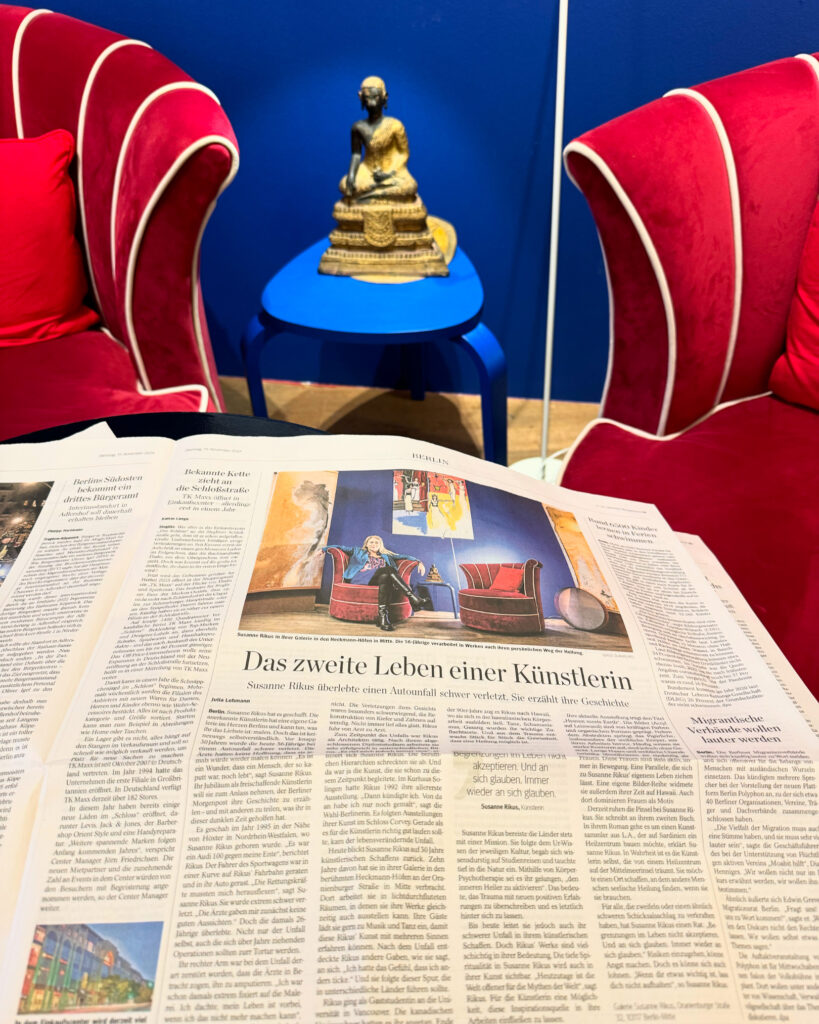
artfacts
Works with Force
New Works by Susanne Rikus
The paintings of the art award winner Susanne Rikus speak directly to her public in a very special way.
It is the force of an authentic and transforming painting fed by wisdom, which produces such an effect. As an opposite pole to hectic daily life, the expressive works create a stimulating and yet calming, unifying and centering atmosphere in space. In it, the viewers can quickly come into their own and have a sense that the message of the paintings is unfolding and allows them to understand in the deep layers of consciousness.
How can such subtile and yet engaging and effective works result, and what makes them so unusual?
Susanne Rikus, actually an architect, uses her grasp of building and its specific surroundings when she gets into the preparation for her artistic works.
For the real painting comes at the end of a long work process. At the beginning is the research. For this, the artist takes an extensive look into and behind the appearances of the traces, which old cultures have left behind in Sardinia, Hawaii, on Vancouver Island or in areas of Africa – whether in the form of buildings or other material and immaterial cultural expressions.
Beyond the scientific-rational exploration of the sources, Susanne Rikus herself goes to these places world-wide, where, over a long period of time, old knowledge was lived and passed on, so as to draw directly from this stored memory.
Directly from this connectedness, she creates her works, in whose aesthetics that information is reflected (river of transformation), but is always maintained on a higher plane and is legible.
Often, this is in connection with nature (Kane, Hawaiian islands, red dance, Hawaiin waterfall) or figurative echoes (duality meet oneness, goddess), but is also abstracted (home of the souls, Hawaiin spirits, rainbow falls).
In clear gestures and with powerful bright colors, Susanne Rikus applies the motifs to mostly large formats layer by layer.
The act of painting itself follows quickly, spontaneously, with sure, confident brushstrokes. This directness and liveliness in the implementation leads to a very expressive, harmonious appearance.
This extends from playful and airy color moments (rainbow falls, Hawaiian home) to compressed, energetic expressions (Domus de Janas, home of the souls). Each of these works is convincing to the same extent in its completely authentic expression. Here Susanne Rikus is developing an aesthetic, which often includes synchronic, bursting and retrieving moments and thus produces that energy mentioned at the beginning.
More recently, she is experimenting with a procedure, in which she transfers photographs to a canvas or a transparent medium like glass or acrylic glass by means of color pigments and processes them further with color. So, photographically held, individual structures of a traditional place can be transferred to a picture and processed.
This way, Susanne Rikus compresses the composition such that the real essence of the image remains inaccessible for the outer eye and yet can be perceived by the observer (goddess). This way, the artist succeeds in expressing the intangible in her paintings.
Not only with back lighting of the transparent art do those works show great expressive power (in the transfer technique), in which the photography can be surmised or appears in parts on the composition (matrix, entering the temple). In the latter work, you might think the female red figure was not approaching an antique temple, but rather the Brandenburg Gate in the metropolis of Berlin.
This is done on purpose, since one intention of Susanne Rikus is to bring old and new together with her artistic works.
Old knowledge as a solid basis can cause the opening up to necessary changes involving the new, the unprecedented. At the same time, it can sharpen the look at common cultural roots, thus promoting tolerance and international understanding.
When the artist works with archetypes, signs and statements of the “cradle of humanity”, then this applies in the sense of a connection, a respectful memory of the primal forces of nature and our responsibility as co-creators of our existence.
This is what makes the works so compelling for the viewer, for there lies a deep, human longing hidden in them. A longing, which we perceive and are barely conscious of, because we have forgotten from where we come and from what sources our spirit and soul, knowledge and culture feed themselves.
The paintings of Susanne Rikus give us an idea of this, let us sense that there are living foundations for it, which make orientation possible for us.
The great service of the artist is that she makes this accessible to us through her works by condensing her inner knowledge in artistic form. Thus, in her painting, she expands the area of informal art by aspects of the visionary, imaginary and transformation.
With her paintings, Susanne Rikus creates understanding beyond the intellect.
In that she connects the viewer of her lively and pulsating works with ancient human knowledge, she opens broad spaces of resonance, in which temporal and spatial distances play no more role.
With such linkage, development in freedom can occur: a vision, which underlies the powerful, subtle and exceptional Oeuvre of Susanne Rikus.
2017, Dr. Ingrid Gardill, Art Historian